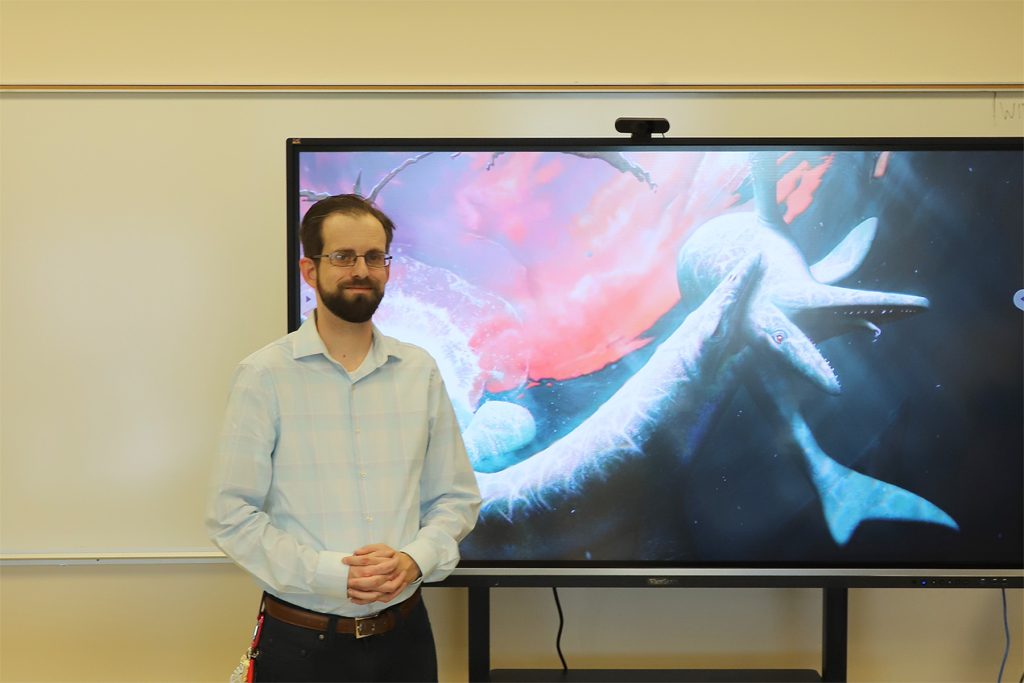MOOREFIELD, W.Va. – At Eastern West Virginia Community and Technical College, the Biological and Environmental Technology program coordinator, Nathan Van Vranken, served as co-author on a research paper for a recent discovery of a brand-new species of mosasaur, they named, Jormungandr walhallaensis. Other co-authors were Amelia Zietlow of the Richard Glider Graduate School and Division of Paleontology at the American Museum of Natural History, and Clint Boyd of the North Dakota Geological Survey.

© Henry Sharpe
Throughout the paper, they describe and name the new genus and species of mosasaur, which is a type of aquatic reptile closely related to snakes and monitor lizards. “The new genus is called Jormungandr walhallaensis in reference to the fossils being collected near the town of Walhalla, North Dakota,” said Van Vranken. In Norse mythology, Jormungandr is the giant serpent said to appear before Ragnarok, the end times. “The tale of Jormungandr, I think, paints a wonderful picture and helps contribute to our understanding of the northernmost regions of the interior seaway, especially with the mosasaurs, and discoveries such as these can pique scientific curiosity,” he says.
Geologically, the fossils come from the Pembina Member of the Campanian aged Pierre Shale, which according to Clint Boyd, is “a small slice of geologic time.” Jormungandr possesses a mosaic of features seen in early and later diverging mosasaurs such as the small-bodied clidastes and the much larger, more famous, Mosasaurus. This mosaic was tested using computer modeling software conducted by Amelia Zietlow to determine its place among the mosasaur family tree.
“Ultimately, I was interested in assisting Amelia and Clint with this project, as one of my areas of focus in paleontology is the biogeography and biostratigraphy of mosasaurs and how their habitats, ranges, and distributions change overtime along the coasts,” said Van Vranken. To better contextualize Jormungandr’s place in its habitat, he used techniques found in Geographic Information Systems (GIS) which allow for the integration of computer hardware and software that store, manage, analyze, edit, output, and visualize geographic data based on fossil occurrences of North American Mosasaurs.
He hopes that the public seeing his work will draw a broader interest to his program at Eastern. “We contribute to cutting-edge research in the science and support both traditional and non-traditional science-related careers which can lead to the development of the Potomac Highlands and surrounding areas by studying innovative topics,” said Van Vranken.
If you are interested in learning more about animals like these or Earth’s past, Van Vranken teaches multiple courses like General Biology and General Physical Science, which introduces students to these topics and more. The Biological and Environmental Technology program can show you how to deploy techniques found in GIS or 3D modeling of natural history specimens, even citizen science-related research. The Biological and Environmental Technology program is currently seeking prospective students for the Spring 2024 semester. If you want to pursue academic work with an emphasis on the natural world and environmental stewardship, please reach out to Nathan Van Vranken at nathan.vanvranken@easternwv.edu or call 304-434-8000 ext. 9263.
Read the research paper at https://digitallibrary.amnh.org/items/13b0485f-c73f-47f9-8d1d-0d4ab6aaedfb
About Eastern
Eastern West Virginia Community and Technical College, based in Moorefield, serves six rural counties in West Virginia’s Potomac Highlands by offering affordable academic programs, including five online degree programs, and a variety of flexible workforce trainings. Eastern is accredited by the Higher Learning Commission. For more information, visit https://easternwv.edu or call 304-434-8000.

© Henry Sharpe
Categories:
